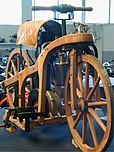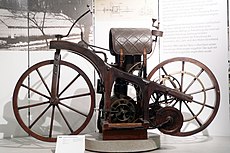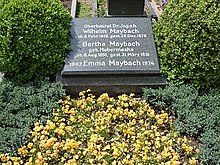Wilhelm Maybach

August Wilhelm Maybach (born February 9, 1846 in Heilbronn ; † December 29, 1929 in Stuttgart-Cannstatt ) was a German designer and automobile pioneer. He was a co-founder of Maybach-Motorenbau GmbH , which was founded in Bissingen / Enz , Kingdom of Württemberg , in 1909 and gave its name to the Maybach automobile brand .
As an employee of Gottlieb Daimler's design office, Wilhelm Maybach developed the so-called “ grandfather clock ”, the first light and fast-rotating internal combustion engine that was particularly suitable as a vehicle engine .
Live and act
Childhood and youth
When Wilhelm Maybach was five years old, his family moved from Heilbronn ( Württemberg ) to Stuttgart , 50 km away , where both of his parents died within three years. As a result, Wilhelm Maybach was accepted into the Reutlinger Bruderhaus at the age of 13, where orphans from poor families received education and training. Maybach was trained there as a technical draftsman and designer .
Gottlieb Daimler and Maybach made acquaintance in the brother house in Reutlingen

|

|
|
|
Daimler riding car replica from 1885, Gottlieb Daimler and Wilhelm Maybach constructed the riding car , a forerunner of the motorcycle
|
||
Maybach and Gottlieb Daimler met in the brother's house . Daimler was the head of the brother house's machine factory and was assigned to Maybach as an assistant. Daimler recognized Maybach's talent and became his sponsor. In 1873 Gottlieb Daimler took Maybach to the Deutz gas engine factory near Cologne. In the Deutz AG gas engine factory, Maybach was given responsibility for the design office. Here Maybach brought the combustion engine with external ignition developed by Nikolaus Otto to series production. When Daimler founded the Daimler-Motoren-Gesellschaft in Cannstatt , Maybach became its technical director and thus played a key role in the further development of the automobile.
Groundbreaking encounter between Wilhelm Maybach and Consul Emil Jellinek
Around 1900, at the suggestion of the Austrian businessman and consul general Emil Jellinek (1853–1918) , Maybach constructed the Mercedes-Simplex , a racing car with a 35-hp four-cylinder engine and two carburetors. The vehicle, equipped with Maybach's inventions, the honeycomb cooler and the gear transmission, represented the car of the future for the time. Jellinek named the model after his daughter Mercédès . In 1904 Maybach developed the first six-cylinder Mercedes engine with 70 hp. In 1906 he designed a pioneering 120 hp racing engine with hanging inlet and outlet valves, an overhead camshaft and dual ignition . These characteristics later became important for the Mercedes aircraft engines ( Mercedes D III ) and for all other high-performance engines.
Mercedes-Simplex from 1902 with a Maybach engine
Maybach Cabrio Museum Sinsheim Parcours with a stop in Heidelberg
Maybach Zeppelin DS 8 with a twelve-cylinder engine
Family and company foundation of Maybach-Motorenbau GmbH

Maybach married Bertha Wilhelmine Habermaahs (1851–1931), Maulbronn's landlord and post office owner's daughter , in 1878 ; Their first son Karl Maybach († 1960) was born in Deutz in 1879 , followed in 1884 by the second son Adolf († 1940 in Grafeneck ) and daughter Emma, born in 1892 († 1974).
Together with his son Karl , Maybach started his own business in 1909 , and together they founded Maybach-Motorenbau GmbH in Bissingen / Enz , which initially manufactured engines for rigid airships ( zeppelins ) and later luxury cars in Friedrichshafen (see also MTU Friedrichshafen ).
Wilhelm Maybach lived in his villa on Freiligrathstrasse in Cannstatt until his death, which has been preserved to this day. He died there on December 29, 1929. Maybach was buried in the immediate vicinity of Gottlieb Daimler in the Cannstatter Uff churchyard .
The Maybach automobile brand, which was discontinued at the end of 2012, belonged to Daimler AG .
See also
- Mercedes-Benz World Stuttgart-Bad Cannstatt
Honors
- 1916 Wilhelm Maybach was from the Technical University of Stuttgart , the honorary doctorate awarded.
- In 1922 he was awarded the Grashof Memorial Medal from the Association of German Engineers .
Wilhelm Maybach is named for the following institutions:
- for the Wilhelm-Maybach-Schule, commercial vocational school in Stuttgart-Bad Cannstatt
- for the Wilhelm Maybach School in Heilbronn, which is a technical school center for education and training with a technical high school and is particularly active in the areas of manufacturing, metal, automotive and electrical engineering
- for the Wilhelm Maybach Oberschule 5. OR Spandau (secondary school) in Berlin-Spandau
- for the Wilhelm-Maybach-Schule, promotional vocational school and promotional vocational school in Reutlingen
- for the Wilhelm Maybach Laboratory - a technology laboratory of the Science Center experimenta in Heilbronn
literature
- Max JB Rauck: Wilhelm Maybach. The great automobile designer. Rauck, Baar 1979.
- Harry Niemann : Maybach Myth. 4th edition. Motorbuch, Stuttgart 2002, ISBN 3-613-02275-3 .
- Harry Niemann: Maybach. The father of the Mercedes. 3. Edition. Motorbuch, Stuttgart 2000, ISBN 3-613-02027-0 .
- Harry Niemann: Wilhelm Maybach, king of the designers. Motorbuch, Stuttgart 1995, ISBN 3-613-01717-2 .
- Kurt Rathke: Wilhelm Maybach. Dawn of a new age. Gessler, Friedrichshafen 1953.
- Hans Christoph Graf von Seherr-Thoss: Maybach, Wilhelm. In: New German Biography (NDB). Volume 16, Duncker & Humblot, Berlin 1990, ISBN 3-428-00197-4 , pp. 523-525 ( digitized version ).
- Documentary film on behalf of Mercedes-Benz AG 1995: Wilhelm Maybach - King of the Constructors by Harry Niemann BRD 1995/96.
- Reutlinger Artist Lexicon. Visual artists related to the city and district of Reutlingen from the Middle Ages to the present. Nous-Verlag der Kunsthandlung Heck, Reutlingen 1999, ISBN 3-924249-26-1 .
Web links
- Literature by and about Wilhelm Maybach in the catalog of the German National Library
- Search for "Wilhelm Maybach" in the German Digital Library
- Search for "Wilhelm Maybach" in the SPK digital portal of the Prussian Cultural Heritage Foundation
- Susanne Eckelmann: Wilhelm Maybach. Tabular curriculum vitae in the LeMO ( DHM and HdG )
- Wilhelm Maybach
Individual evidence
- ↑ Olaf von Fersen (ed.): A century of automobile history: passenger cars. VDI-Verlag, Düsseldorf 1986, p. 10.
- ^ Christian Löer: Horch, Bugatti & Co: Cologne as the cradle of automobile construction . In: Kölner Stadt-Anzeiger . ( ksta.de [accessed on July 31, 2018]).
| personal data | |
|---|---|
| SURNAME | Maybach, Wilhelm |
| ALTERNATIVE NAMES | Maybach, August Wilhelm (full name) |
| BRIEF DESCRIPTION | German automobile designer and entrepreneur |
| DATE OF BIRTH | February 9, 1846 |
| PLACE OF BIRTH | Heilbronn |
| DATE OF DEATH | December 29, 1929 |
| Place of death | Stuttgart-Cannstatt |




